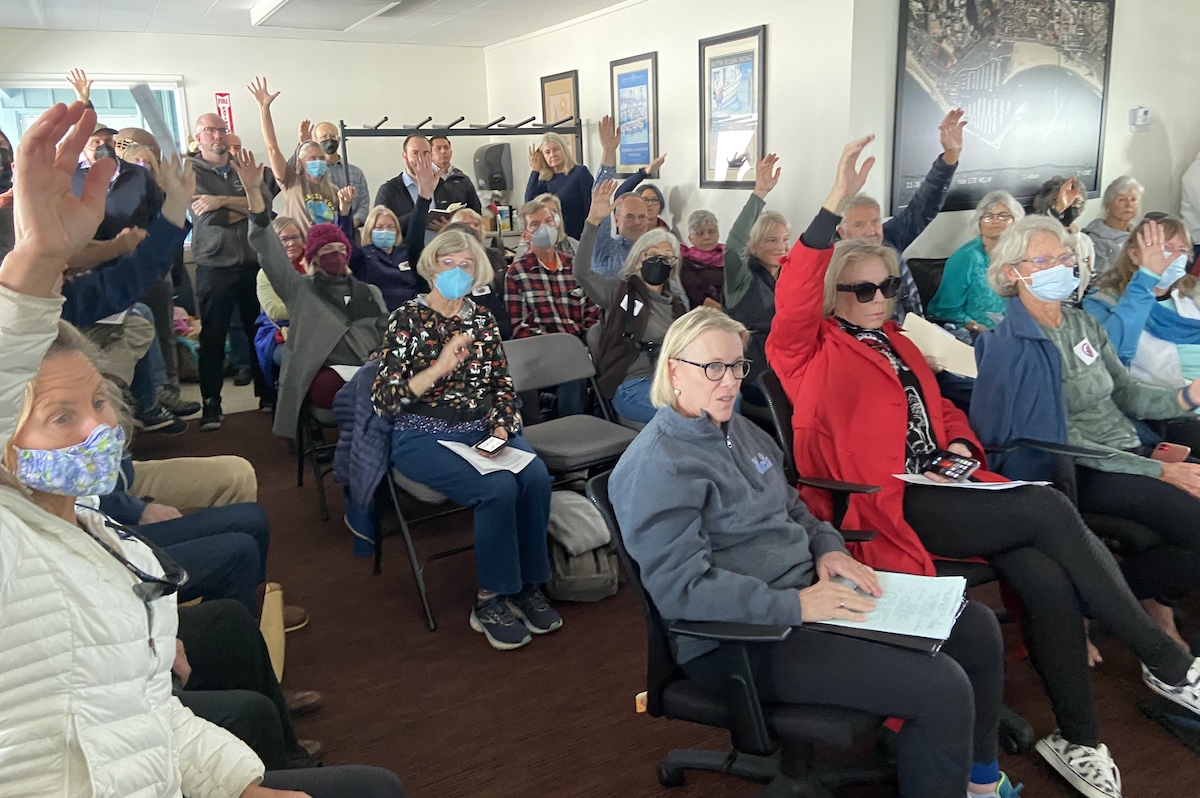Santa Barbara Residents Blast Cruise Ship Program at Public Meeting
Locals Voice Concern over Environmental Impacts, Push for End of Cruise Ships Anchoring Offshore

Santa Barbara residents packed inside a cramped meeting room upstairs in the Marine Center classroom at the harbor on Thursday, eager to voice their concerns over the city’s cruise ship program during the latest meeting of the Harbor Commission’s Cruise Ship Subcommittee.
Waterfront Director Mike Wiltshire opened the meeting with a report outlining the economics of the cruise ship program. Since its inception in the early 2000s, the cruise ship program has grown to host 20-30 ships every year, with 2022 marking its busiest year in more than a decade with 30 ships anchoring in Santa Barbara. COVID forced a temporary shutdown of the program in March 2020, with only five ships visiting from 2020-2021.
The Waterfront Department charges $10 per passenger for each ship that anchors offshore, with most ships averaging anywhere between 200 and 3,500 passengers. According to a survey from Visit Santa Barbara in 2016 — the second-busiest season in the past decade with 29 ships — the program had an estimated economic impact of $3.9 million.
But it wasn’t the economics of the cruise ships that drew so many locals to the subcommittee meeting. The rest of the time was spent discussing the environmental and social impacts of the program, starting with a public display of just how many in the room wanted an end to cruise ships in Santa Barbara.
During the long public comment session, one local asked for a show of hands of who was against the cruise ships. Almost every hand in the crowded room shot up.
Still, there was a handful of business owners and employees in the tourism industry that argued in support of the program, contending that those extra visitors help support struggling small businesses, and many times return for second or third visits after enjoying a first trip to Santa Barbara.
Waterfront Department Administrative Analyst Chris Bell answered to questions about the regulation on emissions and waste discharges by explaining that California has “the most stringent fuel requirements in the world,” and that here locally there are several levels of regulatory agencies ensuring that the cruise ships do not adversely impact the environment.
First, the city requires every ship to sign a Local Captain’s Declaration, in which each vessel agrees not to exceed a speed of 10 knots or discharge any waste within 12 nautical miles of the coast. At the state and federal levels, the California Air Resources Board (CARB), Environmental Protection Agency (EPA), and International Maritime Organization regulate the areas surrounding the Channel Islands extending out 200 nautical miles away from the shore.
Sign up for Indy Today to receive fresh news from Independent.com, in your inbox, every morning.
For many of the public in attendance, these regulations were not enough to feel safe. Some argued that even if ships agree not to discharge within 12 miles of the shore, waste from just outside that border would spread into the waters closer to the shore.
Ben Pitterle, the Science & Policy Director of Santa Barbara Channelkeeper — the self-described “environmental watchdog” boat that patrols the Santa Barbara Channel and monitors water quality and impacts on the marine habitat — said that there are “huge amounts of pollution entering our waters” as a direct result of these cruise ships, even if the ship’s engines are operating at lower speeds.
Santa Barbara County Air Pollution Control District (SBCAPCD) Air Quality Engineer Timothy Mitro provided a report on the air emissions from cruise ships in the county, which showed that one large cruise ship emits twice as many greenhouse gasses as 1,788 passenger car trips from Los Angeles to Santa Barbara (the equivalent of carrying the same amount of passengers). When looking specifically at Nitrogen Oxides (NOx) and Sulfur Oxides (SOx), one cruise ship emits up to 150 times more of the pollutants than car trips.
Mitro also added that the county is currently in “nonattainment” for ozone standards, which means the county exceeds the regular limit once or more per year. He explained that while in the ‘90s the county reported more than 100 days exceeding the limit, that number has dropped to below three days a year, and the county was “real close” to reaching zero days.
The subcommittee members will review the public input from the session and return to the Harbor Commission to discuss any changes that could be made to the cruise ship programs. There will likely be subsequent public hearings to allow for more public input on the program. For more information, and for full details on the reports shown at the meetings, visit the Harbor Commission website.
Support the Santa Barbara Independent through a long-term or a single contribution.



